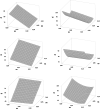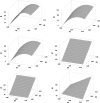The application of pharmaceutical quality by design concepts to evaluate the antioxidant and antimicrobial properties of a preservative system including desferrioxamine
- PMID: 32856238
- PMCID: PMC7704847
- DOI: 10.1007/s40199-020-00370-9
The application of pharmaceutical quality by design concepts to evaluate the antioxidant and antimicrobial properties of a preservative system including desferrioxamine
Abstract
Background: The purpose of the present study was to investigate the antioxidant and antimicrobial activities of a conventional preservative system containing desferrioxamine mesylate (DFO) and optimize the composition of the system through mathematical models.
Methods: Different combinations of ethylenediaminetetraacetic acid (EDTA), sodium metabisulfite (SM), DFO and methylparaben (MP) were prepared using factorial design of experiments. The systems were added to ascorbic acid (AA) solution and the AA content over time, at room temperature and at 40 °C was determined by volumetric assay. The systems were also evaluated for antioxidant activity by a fluorescence-based assay. Antimicrobial activity was assessed by microdilution technique and photometric detection against Staphylococcus aureus, Escherichia coli, Pseudomonas aeruginosa, Candida albicans and Aspergillus brasiliensis. A multi-criteria decision approach was adopted to optimize all responses by desirability functions.
Results: DFO did not extend the stability of AA over time, but displayed a better ability than EDTA to block the pro-oxidant activity of iron. DFO had a positive interaction with MP in microbial growth inhibition. The mathematical models showed adequate capacity to predict the responses. Statistical optimization aiming to meet the quality specifications of the ascorbic acid solution indicated that the presence of DFO in the composition allows to decrease the concentrations of EDTA, SM and MP.
Conclusion: DFO was much more effective than EDTA in preventing iron-catalyzed oxidation. In addition, DFO improved the inhibitory response of most microorganisms tested. The Quality by Design concepts aided in predicting an optimized preservative system with reduced levels of conventional antioxidants and preservatives, suggesting DFO as a candidate for multifunctional excipient.
Keywords: Antioxidant; Desferrioxamine; Design space; Experimental design; Preservative.
Conflict of interest statement
The authors declare that they have no competing interests.
Figures








Similar articles
-
Zinc oxide as a new antimicrobial preservative of topical products: interactions with common formulation ingredients.Int J Pharm. 2015 Feb 1;479(1):88-95. doi: 10.1016/j.ijpharm.2014.12.031. Epub 2014 Dec 16. Int J Pharm. 2015. PMID: 25527211
-
New Natural and Sustainable Cosmetic Preservative Based on Sugarcane Straw Extract.Molecules. 2024 Aug 20;29(16):3928. doi: 10.3390/molecules29163928. Molecules. 2024. PMID: 39203006 Free PMC article.
-
Antimicrobial activity of a new preservative for multiuse ophthalmic solutions.J Ocul Pharmacol Ther. 2013 Jul-Aug;29(6):586-90. doi: 10.1089/jop.2012.0041. Epub 2013 Feb 21. J Ocul Pharmacol Ther. 2013. PMID: 23428175
-
Desferrioxamine and desferrioxamine-caffeine as carriers of aluminum and gallium to microbes via the Trojan Horse Effect.J Trace Elem Med Biol. 2017 May;41:16-22. doi: 10.1016/j.jtemb.2017.01.006. Epub 2017 Feb 3. J Trace Elem Med Biol. 2017. PMID: 28347458
-
Electrochemical Ag+ for preservative use.Appl Environ Microbiol. 1992 Dec;58(12):3834-6. doi: 10.1128/aem.58.12.3834-3836.1992. Appl Environ Microbiol. 1992. PMID: 1476427 Free PMC article.
Cited by
-
Deferoxamine Treatment Effectively Prevents Periodontitis Progression by Reducing Inflammation and Osteoclastogenesis in Experimental Periodontitis Rats.J Inflamm Res. 2024 Nov 25;17:9637-9650. doi: 10.2147/JIR.S490823. eCollection 2024. J Inflamm Res. 2024. PMID: 39618936 Free PMC article.
-
A Bioinspired Flexible Sensor for Electrochemical Probing of Dynamic Redox Disequilibrium in Cancer Cells.Adv Sci (Weinh). 2023 Dec;10(36):e2304079. doi: 10.1002/advs.202304079. Epub 2023 Nov 9. Adv Sci (Weinh). 2023. PMID: 37943018 Free PMC article.
-
Topical Delivery Systems for Plant-Derived Antimicrobial Agents: A Review of Current Advances.Int J Biomater. 2025 Jul 27;2025:4251091. doi: 10.1155/ijbm/4251091. eCollection 2025. Int J Biomater. 2025. PMID: 40756473 Free PMC article. Review.
References
-
- Pifferi G, Santoro P, Pedrani M. Quality and functionality of excipients. Farmaco. 1999;54(1–2):1–14. - PubMed
-
- Abrutyn ES. Deciphering chelating agent formulas. In: Cosmetics & Toiletries. 2013. https://www.cosmeticsandtoiletries.com/formulating/function/aids/premium.... Accessed 12 Nov 2019.
-
- Chaturvedi S, Dave PN. Removal of iron for safe drinking water. Desalination. 2012;303:1–11.
MeSH terms
Substances
Supplementary concepts
LinkOut - more resources
Full Text Sources
Medical
Molecular Biology Databases

